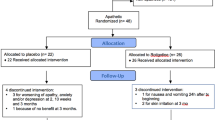Abstract
We studied 54 idiopathic Parkinson’s disease (PD) patients with depressive disorders (DD) to compare the efficacy and the effect of treatment with sertraline in the usual formulation and in the liquid oral concentrate (LOC) formulation. After 6 months of sertraline treatment, the Hamilton Depression Rating Scale and the Montgomery and Asberg Depression Rating Scale showed a decrement (p<0.001, for both formulations). Parkinson’s Disease Questionnaire scores improved (p<0.005 for usual formulation and p<0.001 for LOC formulation), as did Clinical Global Impression-Severity of Illness scale and Clinical Global Impression-Global Improvement scale scores (p=0.1, for both formulations). Mini Mental State Examination and Unified Parkinson’s Disease Rating Scale motor subscores did not change. These results suggest that sertraline LOC may also be a useful treatment for DD in PD patients, especially for those with swallowing problems, and have significant benefit for quality of life, without worsening of parkinsonian features.
Similar content being viewed by others
References
Dooneief G, Mirabello E, Bell K et al (1992) An estimate of the incidence of depression in idiopathic Parkinson’s disease. Arch Neurol 49:305–307
Richard IH (2000) Depression in Parkinson’s disease. Curr Treat Options Neurol 2:263–274
McDonald WM, Richard IH, Delong MR (2003) Prevalence, etiology, and treatment of depression in Parkinson’s disease. Biol Psychiatry 54:363–375
Behari M, Srivastava AK, Pandey RM (2005) Quality of life in patients with Parkinson’s disease. Parkinsonism Relat Disord 11:221–226
Okun MS, Watt RL (2002) Depression associated with Parkinson’s disease: clinical features and treatment. Neurology 58[4 Suppl 1]:S63–70
Yamamoto M (2001) Depression in Parkinson’s disease: its prevalence, diagnosis and neurochemical background. J Neurol 248[Suppl 3]:5–11
Sawabini KA, Watts RL (2004) Treatment of depression in Parkinson’s disease. Parkinsonism Relat Disord 10:S37–S41
Erdal KJ (2001) Depressive symptom patterns in patients with Parkinson’s disease and other older adults. J Clin Psychol 57:1559–1569
Goldestein BJ, Goodnich PJ (1998) Selective serotonin reuptake inhibitors in the treatment of affective disorders-III. Tolerability, safety and pharmacoeconomics. J Psychopharmacol 12[Suppl B]:S55–S87
Rampello L, Chiechio R, Raffaele R et al (2002) The SSRI, citalopram, improves bradykinesia in patients with Parkinson’s disease treated with L-dopa. Clin Neuropharmacol 25:21–24
Tesei S, Antonini A, Canesi M et al (2000) Tolerability of paroxetine in Parkinson’s disease: a prospective study. Mov Disord 15:986–989
Devanand DP, Pelton GH, Marston K et al (2003) Sertraline treatment of elderly patients with depression and cognitive impairment. Int J Geriatr Psychiatry 18:123–130
Hauser RA, Zesiewica TA (1997) Sertraline for the treatment of depression in Parkinson’s Disease. Mov Disord 12:756–759
Davidson JR (2003) Pharmacotherapy of social phobia. Acta Psychiatr Scand Suppl 417:65–71
Brady KT, Clary CM (2003) Affective and anxiety comorbidity in post-traumatic stress disorder treatment trials of sertraline. Compr Psychiatry 44:360–369
Liebowitz MR, Demartinis NA, Weihs K et al (2003) Efficacy of sertraline in severe generalized social anxiety disorder: results of a double-blind, placebo-controlled study. J Clin Psychiatry 64:785–792
Mauri MC, Fiorentini A, Cerveri G et al (2003) Long-term efficacy and therapeutic drug monitoring of sertraline in major depression. Hum Psychopharmacol 18:385–388
Dell’Agnello G, Ceravolo R, Nuti A et al (2001) SSRIs do not worsen Parkinson’s disease: evidence from an open-label, prospective study. Clin Neuropharmacol 24:221–227
Gelb JD, Oliver E, Gilman S (1999) Diagnostic criteria for Parkinson disease. Arch Neurol 56:33–39
American Psychiatric Association (1994) Diagnostic and statistical manual of mental disorders. 4th Edn. American Psychiatric Association, Washington DC
Akdemir A, Turkcapar MK, Orsel SD et al (2001) Reliability and validity of the Turkish version of the Hamilton Depression Rating Scale. Compr Psychiatry 42:161–165
Montgomery SA, Asberg M (1979) A new depression scale designed to be sensitive to change. Br J Psychiatr 134:382–389
Guy W (1976) ECDEU Assessment manual for psychopharmacology. Revised US Dept Health, Education and Welfare publication (ADM). National Institute of Mental Health, Rockville, MD, pp 76–338
Kuopio AM, Marttila RJ, Helenius H et al (2000) The quality of life in Parkinson’s disease. Mov Disorder 15:216–223
Peto V, Jenkinson C, Fitzpatrick R (1998) PDQ-39: a review of the development, validation and application of a Parkinson’s disease quality of life questionnaire and its associated measures. J Neurol 245[Suppl 1]:S10–S14
Antonini A, Tesei S, Zecchinelli A et al (2006) Randomized study of sertraline and low-dose amitriptyline in patients with Parkinson’s disease and depression: effect on quality of life. Mov Disord 21:1119–1122
Gony M, Lapeyre-Mestre M, Montastruc JL(2003) French Network of regional Pharmacovigilance Centers. Risk of serious extrapyramidal symptoms in patients with Parkinson’s disease receiving antidepressant drugs: pharmacoepidemiologic study comparing serotonin reuptake inhibitors and other antidepressant drugs. Clin Neuropharmacol 26:142–145
Author information
Authors and Affiliations
Corresponding author
Rights and permissions
About this article
Cite this article
Marino, S., Sessa, E., Di Lorenzo, G. et al. Sertraline in the treatment of depressive disorders in patients with Parkinson’s disease. Neurol Sci 29, 391–395 (2008). https://doi.org/10.1007/s10072-008-1021-3
Received:
Accepted:
Published:
Issue Date:
DOI: https://doi.org/10.1007/s10072-008-1021-3




